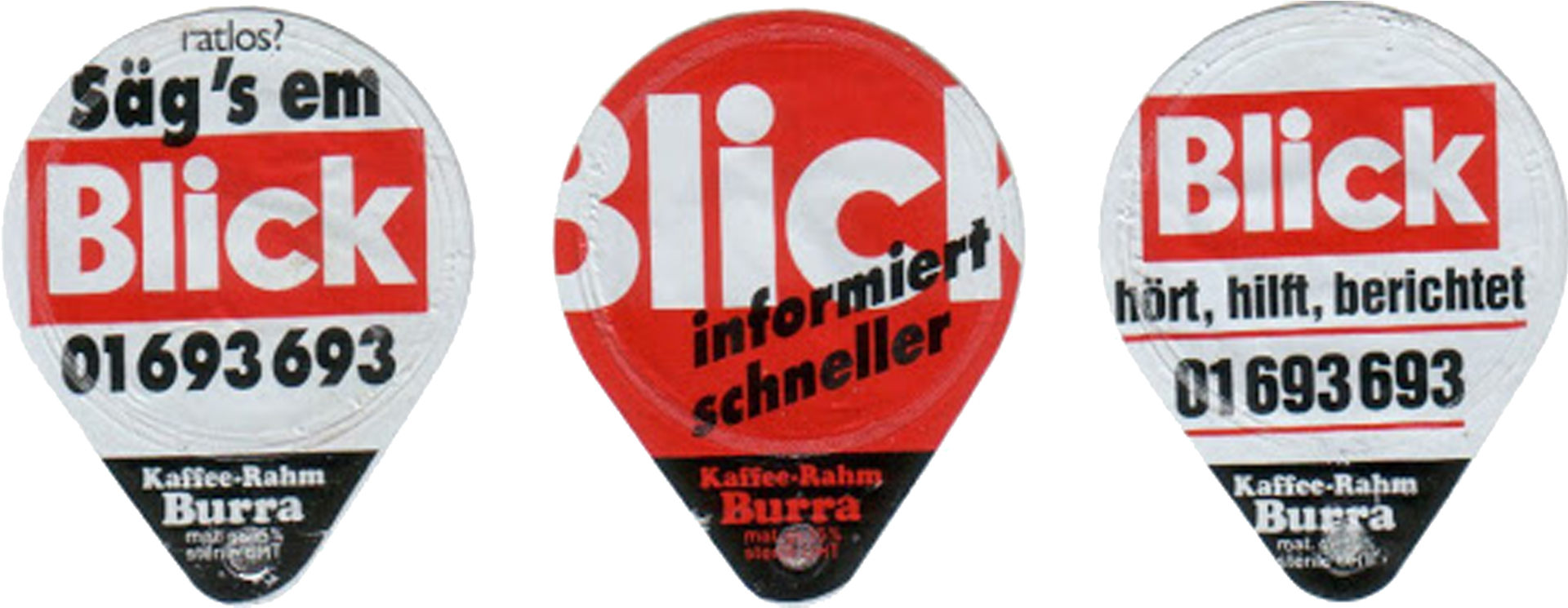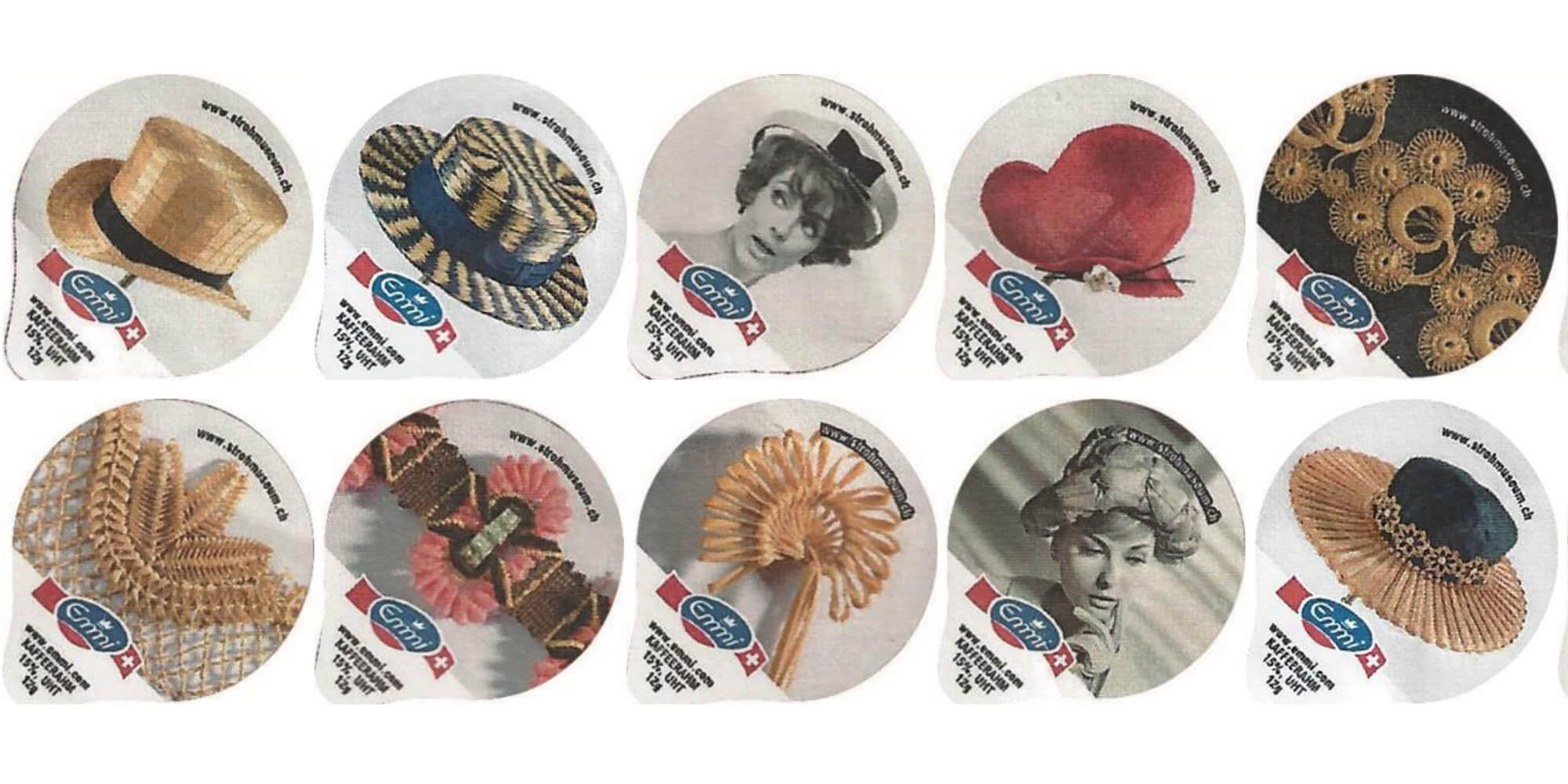Kafirahmdeckeli
Everything you always wanted to know about the probably most extraordinary Swiss passion for collecting!
Kafirahmdeckeli is really a very Swiss collecting passion.
Each coffee comes with coffee cream. At least that's how it feels in Switzerland. And every coffee cream also has a coffee cream lid, or in Swiss: Kafirahmdeckeli. These have a diameter of almost 4 centimetres and are 0.03 to 0.04 millimetres thick. They have a flap with which the lid can be removed. The lids are printed with many theme series. And yes, they are collected. Kafirahmdeckeli is very popular in Swiss collecting circles with a tendency to an older clientele. We would like to get to the bottom of this collecting passion.
The origins
The passion for collecting Kafirahmdeckeli originated in the 1960s. The basis for this is the coffee cream portioned in small cups with lids made of aluminium or composite foil. They became popular in restaurants and private households during this period. The caps offer an eye-catching, effective decoration and advertising space. Portioned coffee cream is produced and consumed all over the world. The lids are decorated with theme series, advertising images or brand prints of the respective manufacturer. In Switzerland, hundreds of theme series and individual images were and are created every year, with flowers, animals, cars, landscapes, sights, aeroplanes, athletes, etc. And Switzerland is the centre of coffee cream cover collecting ("Dechele").
The manufacturers noticed that they were able to increase their sales with new editions. Because Swiss coffee drinkers were willing to buy far more coffee cream than necessary to own all the lids of a version. In order not to damage the caps when taking them off, collectors developed their own techniques for removing the coffee cream, separating the lid from the plastic cup and preparing it for collection. An clip from the SRF Sunday magazine of 1 December 1991 gives exciting insights into the passion for collecting (in German).
Monika Oeggerli, trainer of the Coffee Competence Centre at Schaerer, is also very familiar with coffee cream: "Many of our customers use coffee cream during coffee tastings. Only in this way, they can better check and compare the quality of their coffee. They are probably used to it, and we naturally respond to our customers' wishes - We love it your way! That's why we always have enough coffee cream with many different printed coffee cream covers in the house".
Curiosities
In the 1960s, there were initially isolated collectors of the Deckeli. But already in the 1970s associations and exchange platforms were founded. In the late seventies, the first series with 30 designs appeared.
Some important dates and events in the history of the Kafirahmdeckeli:
- In 1979 the probably most famous series appeared: the Burra advertising series "Blick", which was taken out of circulation because of so-called "foreign advertising". This edition reached five-digit franc amounts among collectors.
- In 1986 the Club Kaffee-Doppelcréme association was founded in Zurich.
- In 1998 a fabricating ring was discovered and in 2000 counterfeits reappeared as "rare series".
Today this passion for collecting is ridiculed. We believe that what is fun and does not harm anyone should be allowed. We are also impressed by the love of detail, discipline, patience and passion that the collectors of Kafirahmdeckeli pursue their hobby.

You have a collection and do not know what to do with it?
The Club Kaffee-Doppelcrème gives some constructive tips here:
It's hard to sell coffee cream covers these days. But if you follow these tips, you have the chance to get a few francs for a collection instead of having to pay disposal fees.
We are looking for covers and series that have rarely been used, misprints, series that have only been used regionally, or variants that were only available for a short time. Not many of these are to be found. But in almost every collection you will find a tiny part, a few covers that are wanted. Let's call these few pieces "the treasures". Precisely this part of a collection is hard to find and thus makes up the value (price) of a whole collection.
This is the most successful way to sell your collection: Take the whole material to a swap meet and try to offer the selection to several interested parties. Ask the organizer at the swap meet. He/she will help you to show the collection to interested collectors. At swap meetings, which are held on Saturdays or Sundays, there are usually more collectors present, the chances of success are accordingly higher.
But there are still many Swiss collecting passions
Switzerland can, in some respects, be considered the land of collectors. The Society for Swiss Art History dedicates an issue of the magazine k+a Kunst + Architektur in der Schweiz to this phenomenon because collecting as a universal phenomenon can be followed in Switzerland like hardly any other country in Europe. You can find more about this issue (in German) here.
Some passionate collectors have given rise to world-famous museums, the Fondation Beyeler in Riehen is probably the best-known example. Lesser-known collectors are certainly worth mentioning: the collection of Peter & Elisabeth Bossard, which was on display at the Kunstzeughaus Zug a few years ago, or the collection of Le Corbusier (sea snails, ceramics from the balcony, flotsam and jetsam and industrial glass), which can be seen at the Museum für Gestaltung in Zurich.
There is a wide variety of collectables: books, old cars, empty or unopened bottles, coins, stamps, beer mats, dolls and salt shakers are just a few examples among many. Bruno S. Frey mentions in his commentary published in German in the NZZ that collecting is an undeniable pleasure, increases the willingness to make more social contacts and subjectively increases life satisfaction. Let’s be honest, each of us has collected something at some point.
"Even the earliest humans collected and exchanged goods for food to ensure their survival," says developmental psychologist Moritz Daum from the Psychological Institute of the University of Zurich. "It is, therefore, quite conceivable that there is a connection between the theory of evolution and developmental psychology." You can read more about this topic here (in German).

